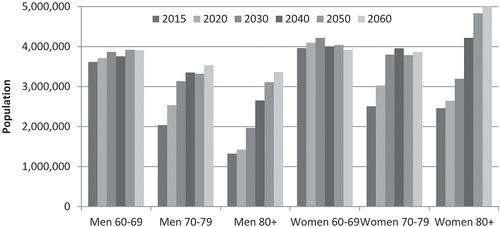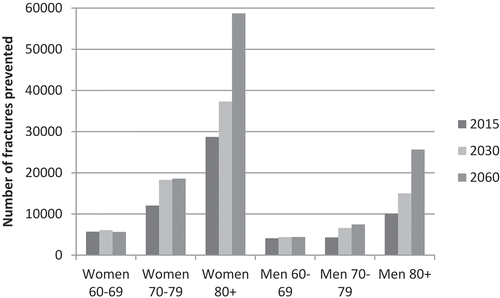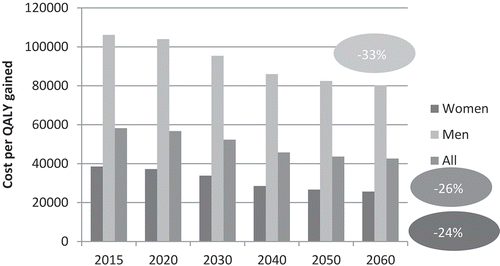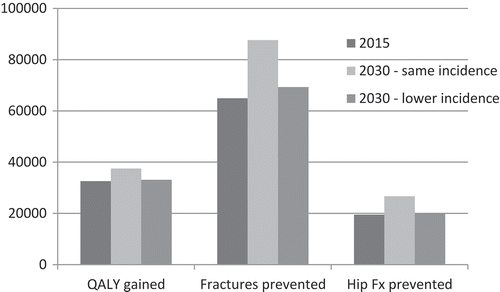ABSTRACT
Background: There is a paucity of research that projects the public health and economic impact of healthcare interventions in the future. In this study, we aimed to estimate the public health and economic impact of vitamin D fortified dairy products for the years 2020, 2030, 2040, 2050 and 2060.
Methods: We used a previously validated Markov microsimulation model that was designed to assess the public health and economic impact of dairy products for fracture prevention in the French general population aged over 60 years in the year 2015.
Results: The expected benefit (in terms of fractures prevented) of the recommended intake of dairy products compared to the absence of appropriate intake is expected to increase by 63% in 2040 and by 85% in 2060. The cost per quality-adjusted life years gained of the appropriate intake of dairy products is expected to decrease from €58,244 in 2015 to €42,616 in 2060.
Conclusion: The potential public health and economic benefits of vitamin D fortified dairy products is expected to substantially increase in the future, especially in the population aged over 80 years. Decision makers should be aware of the current and future potential benefits of dairy products to protect bone fractures.
1. Introduction
Osteoporosis is an increasingly major public health problem worldwide leading to morbidity, excess mortality, and substantial economic cost. In 2010, it was estimated that 22 million women and 5.5 million men have osteoporosis in the European Union, and that 3.5 million new fragility fractures occurred. The economic burden of incident and previous fractures was further estimated at €37 billion [Citation1]. Fortunately, different treatment options are available to reduce the risk of fractures, including pharmacological treatment, non-pharmacological treatment and nutrition [Citation2].
To help decision makers allocating scarce resources devoted to osteoporosis, assessing the public health and economic impact of interventions is becoming increasingly important [Citation3]. Economic evaluation is nowadays increasingly used to inform decision makers about the value for money of health interventions. In recent years, several economic evaluations have been conducted to assess the public health and economic impact of anti-osteoporosis medications [Citation4]. With the increasing recognizing of the value of calcium and vitamin D to protect bone health, several studies have assessed the public health and economic impact of vitamin D fortified dairy products [Citation5–Citation9]. Dairy products are rich in nutrients that are essential for good bone health, including calcium, vitamin D, protein, potassium, phosphorus, and other micronutrients and macronutrients that are known to positively influence bone and muscle homeostasis, hence fracture risk. In a recent French study, we estimated that the recommended intake of dairy products in the general French population over 60 years during 1 year would lead to a lifetime reduction of 64,932 fractures and of 32,569 quality-adjusted life years (QALY) gained. The cost per QALY gained of appropriate dairy intake compared to no appropriate intake was estimated at €58,244 [Citation7].
Little is currently known about projections of the public health and economic impact of all these interventions in the future. Osteoporosis affects mainly elderly patients and given increasing life expectancy, the burden of osteoporosis is expected to increase [Citation1]. Understanding the projections of the public health and economic impact of interventions could reinforce the need of these interventions and help decision makers in formulating (long-term) healthcare policy concerning osteoporosis. In this study, we therefore aimed to estimate the projected public health and economic impact of vitamin D fortified dairy products for fracture prevention in the French general population aged over 60 years. Using a microsimulation model that was specifically designed to assess the public health and economic burden of vitamin D fortified dairy products in France [Citation7], projections for the years 2020, 2030, 2040, 2050, and 2060 were conducted in this study.
2. Methods
We used a previously validated Markov microsimulation model that was specifically designed to assess the public health and economic impact of vitamin D fortified dairy products for fracture prevention in the French general population aged over 60 years in the year 2015 [Citation7]. The model has been previously described and extensively used to assess the public health and economic impact of anti-osteoporosis medications [Citation9,Citation10]. The model simulates over lifetime the number of fractures (including hip, clinical vertebral, wrist, other), life years, QALY and healthcare costs of interventions.
Analyses were conducted in the general population in France aged over 60 years. In both genders, three age cohorts (60–69 years, 70–79 years, 80+) were used to estimate outcomes using TreeAge Pro 2011 (TreeAge Pro Inc., Williamston, MA). For each of the six cohorts, a total of 1,000,000 microsimulations were run. We estimated the impact of vitamin D fortified dairy products to all individuals during one year (2020, 2030, 2040, 2050, and 2060) and estimated the lifetime effect of this intervention. Based on populations projections in each cohort that was obtained from the National Institute of Statistics and Economic Studies (INSEE) [Citation10] (see ), we then calculated using an Excel sheet the total costs and outcomes in the general French population aged above 60 years. According to INSEE, by 2040, the French population aged over 60 years is expected to increase by 40% in men and by 36% in women, with a more marked increase in the population aged over 80 years. Increases of 154 and 104% are expected in men and women in these populations, respectively [Citation10].
Figure 1. Projections of population estimates in the general French population aged over 60 years (based on data from INSEE).

A detailed description of the model and data could be found in Hiligsmann et al. [Citation7]. In brief, the hip fracture incidence in the general population was derived from the recent study of Briot et al. [Citation11] using data from the year 2013. The same fracture incidence was assumed for all projections in the base case. Although not confirmed by all studies, some studies revealed that the hip fracture incidence has decreased in recent years [Citation12]. In France, a similar pattern has been observed for hip fracture [Citation11]. As there is uncertainty about the (long-term) continuity of this trend in the future and the extrapolation to all fracture types, we only assumed in a sensitivity analysis that the fracture incidence will decrease in the future in line with the decrease observed between 2004 and 2013 in France, estimated yearly at 1.0% for women and 0.1% for men in the population aged above 60 years. This decrease was assumed for all fracture types.
We used a healthcare perspective for the cost estimation. The costs of fractures expressed in €2015 were estimated at €11,970; €6,201; €2,124; and €2,093 for hip; clinical vertebral; wrist; and other fractures, respectively [Citation7]. Long-term costs following hip fracture, excess mortality after fracture, and reductions in quality of life after fractures was included in the model, conforms to the previous study [Citation7].
The effect of adequate intake of calcium and vitamin D on fracture risk was derived from a Cochrane Review [Citation13]. Vitamin D and calcium supplementation was assumed to reduce the risk of hip fracture, clinical vertebral, wrist and other fractures by was 16, 14, 11, and 11%, respectively. In the model, people only received fortified dairy products for one year (2020, 2030, 2040, 2050, or 2060) and no further effect was assumed after the year of treatment. The model has however a lifetime horizon to capture the long-term benefits of preventing fractures in the year of the intake of fortified dairy products. The cost of one vitamin D-fortified dairy product was estimated at €0.27 in France based on the prices of two leading industry suppliers from three French cities for vitamin D-enriched milk and yogurt (on the date of 20/01/2016). Based on current consumption of calcium and vitamin D in France and European recommendation on adequate levels [Citation14,Citation15], two vitamin D fortified dairy products per day (by example yogurt fortified with vitamin D or one glass of milk) are needed to achieve optimal intake of calcium and vitamin D. It is generally considered that one dairy product contains 300 mg of calcium and 200 UI of vitamin D. We therefore assumed the price of two dairy products per day in the base case for the economic analysis.
2.1. Presentation of results
We estimated the lifetime number of all fractures prevented, lifetime number of hip fracture prevented, life-years gained and QALY gained of recommended dairy intake versus absence of appropriate intake for each projected year (i.e. 2020, 2030, 2040, 2050, and 2060). Data were also presented by gender and age group. Incremental cost-effective ratios (ICERs) were estimated for the recommended intake of fortified dairy products versus usual care. ICERs are expressed as the differences in costs between alternatives divided by their differences in QALYs). An ICER represents then the cost per QALY gained of recommended intake of fortified dairy products compared to the absence of appropriate intake.
3. Results
3.1. Public health impact
For the year 2015, the recommended intake of fortified dairy products compared to the absence of appropriate intake for the French population aged over 60 years would reduce the total lifetime number of fractures by 64,932 [Citation7]. The expected number of prevented fracture is expected to increase by 63% in 2040 and by 85% in 2060 (). A total of 120,433 lifetime fractures could then prevented by a recommended intake of fortified dairy products in the year 2060. The effect on hip fractures is even higher with an expected increased number of hip fractures prevented of 68% in 2040 and 93% in 2060.
Figure 2. Projection of the impact of the recommended intake of fortified dairy products on the number of all fractures (a) and of hip fractures (b) prevented.

Projection suggested that an additional 74% of QALY and 67% of additional life-years could be gained in the year 2060 because of demographic changes. A higher gain is observable for both outcomes in men than in women.
The distribution of the number of fractures prevented per gender and age groups could be found in for the years 2030 and 2060. The number of fractures prevented in the population aged between 60 and 69 years is expected to only increase by 3% by 2060. On the other hand, the number of fractures prevented is expected to increase by 59% in the group age 70–79 years and by 117% in patients aged over 80 years.
Figure 3. Projection of the impact of the recommended intake of fortified dairy products on number of fractures prevented per gender and age group.
The bars represent the number of fractures prevented with an appropriate intake of fortified dairy products during the years 2015, 2030 and 2060, and stratified according to age range and gender.

3.2. Economic impact
The projection of the cost per QALY gained of appropriate intake of fortified dairy products compared with the absence of appropriate intake is reported in . The ICER, estimated at €58,244 per QALY gained in the French population aged over 60 years in 2015, is expected to decrease to €45,732 in the year 2040 and to €42,616 in 2060. In women aged over 60 years, the incremental cost-effectiveness ratio is expected to decrease by 33% from €38,526 in 2015 to €25,620 in 2060. In men, the cost per QALY gained would be reduced by 24%, from €106,113 to €80,288. It is observed that the cost per QALY gained of appropriate intake of fortified dairy products is substantially higher in men than in women, respectively, estimated at €95,041 and €33,844 for the year 2030.
Figure 4. Projection of the cost per QALY gained of the appropriate intake of fortified dairy products compared with the absence of appropriate intake.
The bars represent the cost (in €) per QALY gained of the appropriate intake of fortified dairy products for the year 2015, 2020, 2030, 2040, 2050 and 2060. Analyses are presented overall as well as for men and women separately. The decrease (in %) in the cost per QALY gained between 2015 and 2060 are reported in the circles.

3.3. Sensitivity analysis
Even when assuming an annual decrease in fracture incidence of 1.0% in women and 0.1% in men, the potential public health impact of dairy products would increase in 2030 compared to 2015 (see ). The increase in the number of fractures prevented and of QALY gained would be 2 and 7%, respectively, compared to estimations of 15 and 35% when assuming the same fracture incidence in the future.
Figure 5. Sensitivity analysis on the effect of dairy products on public health outcomes according to trend of fracture incidence.
The bars represent the total effects (expressed in total QALYs gained, total number of fractures prevented and total number of hip fractures prevented) of the appropriate intake of fortified dairy products for the years 2015 and for the year 2030 assuming a similar fracture incidence than actually and a decrease in fracture incidence.

4. Discussion
This study is one of the first to project the public health and economic impact of healthcare interventions in the future. Our study suggests that the expected benefit of the recommended intake of fortified dairy products compared to the absence of appropriate intake for the French population in France is expected to substantially increase. About 64 and 85% of additional fractures are expected to be prevented in the years 2040 and 2060, respectively. In addition, the cost per QALY gained of the appropriate intake of dairy intake compared to the absence of appropriate intake is expected to decrease from €58,244 in 2015 to €42,616 in 2060, and the intervention will therefore become even more cost-effective. In another study, Sandmann et al. [Citation9] also suggested a higher benefit of food fortification program in Germany in the future, with an annual net savings from a vitamin D and calcium food fortification program increasing by €17 million to €332 million by the year 2025 and by €63 million to €378 million by the year 2050.
Our previous study conducted for the year 2015 already revealed that the intake of vitamin D fortified dairy products has the potential to substantially reduce the burden of osteoporotic fractures and could be an economically beneficial strategy in France [Citation7]. This specific study reinforce the value of intake of vitamin D fortified dairy products, suggesting an even higher public health benefit and improved economic value in the future. Interestingly, the increased benefits of vitamin D fortified dairy products are especially observed in the population aged over 80 years which should be a target population. Given the higher increase risk and life expectancy in women, the economic value of dairy products was shown to be better in women than in men. This study could then be useful for decision makers in formulating (long-term) healthcare policy concerning osteoporosis and clinicians should prioritize the use of vitamin D fortified dairy products in their patients, especially in very elderly patients.
There are some limitations of our study. First, our study suffers of some limitations that have been described in the previous study [Citation7], including the lack of the incorporation of other potential benefits of calcium and vitamin D supplementation, the absence of efficacy data specific to dairy products or the lack of adherence data about dairy products. In addition, any future projections could be uncertain especially in the long term. Population projections were derived from INSEE estimations but are revised over a regular basis. Fracture incidence could also change over time [Citation12]. A sensitivity analysis was conducted to assume a potential reduction in fracture incidence.
5. Conclusions
Despite these limitations, this study suggests that the potential public health and economic benefits of vitamin D fortified dairy products is expected to substantially increase in the future, and especially in the population aged above 80 years. Decision makers should be aware of the current and future potential benefits of vitamin D fortified dairy products to protect bone fractures.
Key issues
The potential public health and economic benefits of vitamin D fortified dairy products is expected to substantially increase in the future.
In terms of fractures prevented, the expected benefit of the recommended intake of dairy products is expected to increase by 85% between 2015 and 2060.
The increased benefits of vitamin D fortified dairy products are especially observed in the population aged over 80 years which should be a target population
Decision makers should be aware of the current and future potential benefits of dairy products to protect bone fractures.
Declaration of interest
JY Reginster has received research grant and/or consulting fees from Servier, Novartis, Negma, Lilly, Wyeth, Amgen, GlaxoSmithKline, Roche, Merckle, Nycomed-Takeda, NPS, IBSA Genevrier, Theramex, UCB, Asahi Kasei, Endocyte, Merck Sharp and Dohme, Rottapharm, Teijin, Teva, Analis, NovoNordisk, Ebewee Pharma, Zodiac, Danone, Will Pharma, Meda, Bristol Myers Squibb, Pfizer, Organon, Therabel, Boehringer, Chiltern, Galapagos. The authors have no other relevant affiliations or financial involvement with any organization or entity with a financial interest in or financial conflict with the subject matter or materials discussed in the manuscript apart from those disclosed.
Additional information
Funding
Notes on contributors
Mickael Hiligsmann
Mickael Hiligsmann was involved in the conception and design, analysis and interpretation of the data and drafting of the paper. Jean-Yves Reginster revised it critically for intellectual content. All authors approved the version to be published; and agree to be accountable for all aspects of the work.
References
- Svedbom A, Hernlund E, Ivergard M, et al. Osteoporosis in the European Union: a compendium of country-specific reports. Arch Osteoporos. 2013;8:137.
- Kanis JA, McCloskey EV, Johansson H, et al. European guidance for the diagnosis and management of osteoporosis in postmenopausal women. Osteoporos Int. 2013;24(1):23–57.
- Kanis JA, Hiligsmann M. The application of health technology assessment in osteoporosis. Best Pract Res Clin Endocrinol Metab. 2014;28(6):895–910.
- Hiligsmann M, Evers SM, Ben Sedrine W, et al. A systematic review of cost-effectiveness analyses of drugs for postmenopausal osteoporosis. Pharmaco Economics. 2015;33(3):205–224.
- Ethgen O, Hiligsmann M, Burlet N, et al. Public health impact and cost-effectiveness of dairy products supplemented with vitamin D in prevention of osteoporotic fractures. Arch Public Health. 2015;73:48.
- Ethgen O, Hiligsmann M, Burlet N, et al. Cost-effectiveness of personalized supplementation with vitamin D-rich dairy products in the prevention of osteoporotic fractures. Osteoporos Int. 2016;27(1):301–308.
- Hiligsmann M, Burlet N, Fardellone P, et al. Public health impact and economic evaluation of vitamin D-fortified dairy products for fracture prevention in France. Osteoporos Int. 2017 Mar;28(3):833–840.
- Lotters FJ, Lenoir-Wijnkoop I, Fardellone P, et al. Dairy foods and osteoporosis: an example of assessing the health-economic impact of food products. Osteoporos Int. 2013;24(1):139–150.
- Sandmann A, Amling M, Barvencik F, et al. Economic evaluation of vitamin D and calcium food fortification for fracture prevention in Germany. Public Health Nutr. 2015:1–10. https://www.ncbi.nlm.nih.gov/pubmed/26568196
- INSEE. Projections de population 2007 – 2060 en France Métropolitaine. INSEE (Institut National de la Statistique et des Études Économiques). https://www.insee.fr/fr/statistiques/2517722?sommaire=2020101
- Briot K, Maravic M, Roux C. Changes in number and incidence of hip fractures over 12 years in France. Bone. 2015;81:131–137.
- Cooper C, Cole ZA, Holroyd CR, et al. Secular trends in the incidence of hip and other osteoporotic fractures. Osteoporos Int. 2011;22(5):1277–1288.
- Avenell A, Mak JC, O’Connell D. Vitamin D and vitamin D analogues for preventing fractures in post-menopausal women and older men. Cochrane Database Syst Rev. 2014;4:CD000227.
- Fardellone P, Cotte FE, Roux C, et al. Calcium intake and the risk of osteoporosis and fractures in French women. Joint, Bone, Spine: Revue Du Rhumatisme. 2010;77(2):154–158.
- Rizzoli R, Boonen S, Brandi ML, et al. Vitamin D supplementation in elderly or postmenopausal women: a 2013 update of the 2008 recommendations from the European Society for Clinical and Economic Aspects of Osteoporosis and Osteoarthritis (ESCEO). Curr Med Res Opin. 2013;29(4):305–313.

